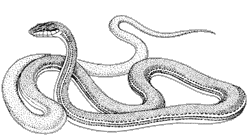Sonoran Whipsnake
(Masticophis bilineatus)
Order: Squamata
Family: Colubridae
Spanish names: alicantre, chirrionero
Description
The Sonoran whipsnake is a long, slender snake reaching lengths between 2 and 5 feet (60 to 150 cm). The head is broad with large eyes. It is olive or bluish-gray fading to yellow towards the tail, with 2 or 3 light-colored stripes on each side. The belly is cream fading to pale yellow towards the tail.

Range
Chiefly a Mexican species, the Sonoran whipsnake enters the United States in extreme southwestern New Mexico and southeastern to west-central Arizona. In Mexico, it is found south to Oaxaca.
Habitat
The Sonoran whipsnake is most commonly found in rocky canyons, riparian areas, foothills and mountains with dense vegetation in elevations up to 6100 feet (1800 m). However, this snake is also found in open creosote bush flats. It is equally at home on the ground or in low, shrubby vegetation. Look for the Sonoran whipsnake in areas with ocotillos, saguaros, and palo verdes, but also in chaparral, cottonwood, juniper, and pine-oak forests.
Life History
This fast-moving snake is primarily active in the early morning from March to October. When hunting, the Sonoran whipsnake may elevate its head off the ground and scan the surrounding area for possible prey. When a bird, lizard or frog is spotted, the snake will seize and swallow the prey without killing it first. Six to 13 eggs are laid in June and July.
The Sonoran whipsnake bites readily if handled.










